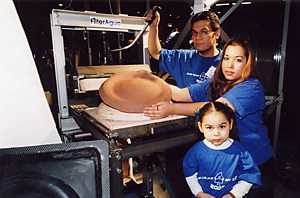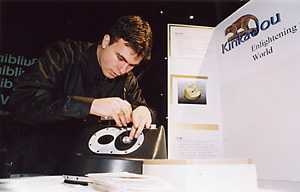Seniors in 2.009 ("Product Engineering Processes") used their ingenuity this semester to design goods for people in the developing world or with disabilities, "folks not currently represented in our focus groups."
The students displayed their wares and business plans last week at end-of-term presentations to venture capitalists, engineers and business executives, who evaluated the products' viability in the appropriate marketplace.
"The board of directors has decided that it may make fiscal and philosophical sense to ... test our viability as designers... In short, we have been asked to find out if we can do well by doing good," said the assignment for this senior-level mechanical engineering design course, which requires students to operate as part of a team of corporate designers. Students must present ideas - and take those ideas back to the drawing board again and again until approval is granted - then, operating within a strict $6,000 budget, build a working prototype, write a business plan and put together a product presentation.
Students were asked to identify customers in "underserved markets" who might benefit from the new devices. The product "may be the genesis of an experiment to change a local economy ... improve health or eliminate a continuous struggle," said the assignment made by a team of instructors led by Woodie Flowers, the Pappalardo Professor of Mechanical Engineering.
The teams of young engineers designed a ceramic water filter system, a vaccine cooler to transport medicines, a community water purification system, a game table for autistic and developmentally challenged children, and a projection system that doesn't require electricity.
Course sponsors are the Lemelson Foundation, Ford Motor Co., United Technologies and General Motors.
2.009 Products
- Filter Agua , a ceramic water filter system for use where poor water quality and poverty are the norm
- Vaccine Co2ler , a battery-operated cooler with dry ice used to transport medicines to remote locations
- NAIAD , a community water purification system for villages with electricity
- Kool Pool , a game table for autistic and developmentally challenged children
- Kinkajou Projection System , a battery-operated microfilm projector
A version of this article appeared in MIT Tech Talk on December 11, 2002.







